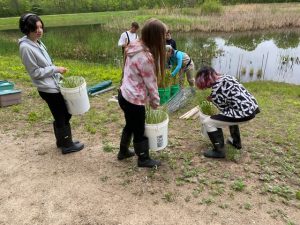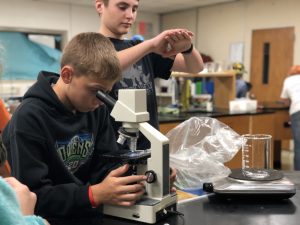As a first-year science teacher at Aldo Leopold Community School in Green Bay, Wis., Mark Valentine was looking for experts to help him teach lessons about our environment and ecosystems. He found the perfect way to fulfill this goal: growing wild rice in the classroom.
Valentine was one of 17 teachers and more than 400 students from 14 schools who participated in the University of Wisconsin–Green Bay’s Wild Rice in the Classroom program during the 2021-2022 school year. The program engages local teachers and K-12 students in conservation efforts that enhance native wetland plant communities in the Bay of Green Bay coastal wetlands and beyond.

Teachers are given all the materials — lights, buckets, growing medium and wild rice seed — to successfully grow the rice. They also learn about the historical, cultural and ecological importance of Manoomin (wild rice in Ojibwe).
“The students and I learned so much about the importance of wild rice for indigenous people and the ecosystem where it grows,” Valentine says. “It felt extra special to be a part of the process of helping to restore this plant to the watershed.”
In May 2022, UW-Green Bay staff and students hosted a series of field trips to L.H. Barkhausen Waterfowl Preserve in Suamico, Wis., where teachers and more than 100 students transplanted their plants as part of a wetland restoration effort. In addition, students learned about freshwater turtles and met a painted turtle education ambassador, participated in a nature walk, and engaged in an interactive activity with Atlas Science Center staff to simulate the environmental and economic impacts of invasive species.
“Students were able to actively participate in the growing and planting of a native species to combat a non-native. This activity gave them a sense of ownership of their environment and what they did does matter,” says Lynn Ponto, a teacher at Weyauwega-Fremont High School Science in Weyauwega, Wis. “Being able to plant under the guidance of professionals allowed them to feel the importance of protecting the diversity in our environment.”
Students also learned about diverse water science career experiences. Valentine says listening to UW-Green Bay students share their stories about pursuing degrees and careers in the natural resources inspired his students.
“Many of my science students dream of following similar paths in the future!” he says.
The field trips were supported by UW-Green Bay’s College of Science, Engineering and Technology, Atlas Science Center, Brown County Parks, and Ducks Unlimited, with funding from the U.S. Fish and Wildlife Service Coastal Program and NEW Water.
This year, the Freshwater Collaborative of Wisconsin provided funding to UW-Green Bay to expand the program and further develop an educator network that will link water-related research activities in the region; help teachers share curriculum, best practices, data and resources; and fuel continued engagement in water science and student career development.
These kinds of collaborations are important to Dave Landers, a sixth-grade science teacher at Pulaski Community Middle School in Pulaski, Wis., and Kelly Koller, technology integration specialist at Bay View Middle School in Green Bay. They facilitate an after-school program called Great Lakes Explorers, which connects students to the Great Lakes watershed. The wild rice program was a fantastic activity for the group.

“Students really enjoyed planting our wild rice at Barkhausen, learning more about the cultural and scientific significance of wild rice in our area and doing other ecosystem-related activities,” Koller says.
Landers says place-based experiences engage and empower students to better understand the ecosystem, gain a cultural perspective and then take action within their local watersheds. It could also prompt them to explore water-related careers.
“One of the highlights was surely putting on the rubber boots and getting their hands wet and feet dirty as they seeded and later planted the wild rice,” he says. “This experience is a great example of using the outdoor learning classroom to foster and engage students’ natural curiosity and wonder.”

